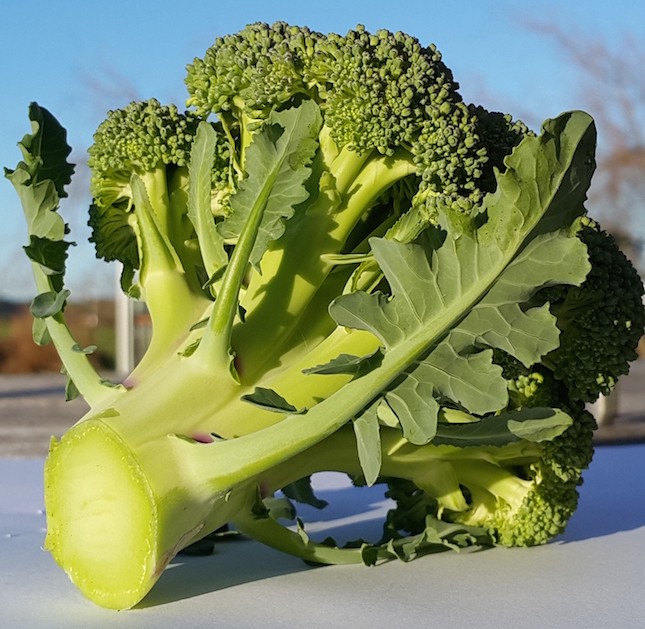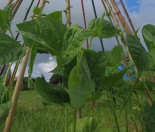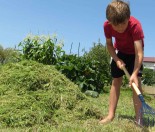Brassicas. These are all the good green favourites that as a kid you were made to eat because they were good for you, and if you were lucky it wasn’t boiled to a grey mush. We are talking about broccoli, cabbage, cauliflower, Brussel sprouts and the uber trendy kale.
The brassica family can be grown from spring to autumn and planting a few every few weeks across the growing season will ensure a continuous supply. Sowing seeds is the easiest and most affordable way to go and is especially great as you are able to control how the plant is treated through its entire life. This is important because if they dry out, even once at any stage in their life they are at greater risk of just bolting straight to seed and not giving you anything to eat at all.
Brassica grow into quite large plants and so they should be spaced 40cm away in all directions from other plants and love a rich, well prepared soil. Once you have lovely seedlings ready for the garden you need to do something that I would never recommend for any other plants except brassicas. Most plants need fluffy soil. But Brassicas like it firm so tread on the soil – not until it is compacted and impossible to poke your finger into, but so it is firm. This is known as ‘the gardeners shuffle!’ Under normal circumstances I wouldn’t recommend standing on your garden once you have prepared your soil.
Then dig a hole slightly bigger than the root ball and fill it with water and let it drain away. Repeat several times. This is called ‘puddling’ and also gives your plants a good start because if brassicas are allowed to dry out then there is a high chance they will bolt straight to seed without doing what they are supposed to do, namely give you something to eat!
Place the plants in the hole and bury them up to the level they were in the seed tray, and firm the soil down around the plant. Pop a label beside them so you know what you are growing.
Make sure you water consistently so the soil doesn’t dry out, but don’t overwater. Dry, soggy or an intermittent yoyo effect of both of them will compromise the health of your crop and make it vulnerable to pest and disease.
Brassicas are vulnerable to a wide range of pests, like slugs, snails and aphids, but by far the biggest nemesis is the White cabbage butterfly – This is the worst pest for the summer growing brassicas as they are everywhere and this year is reported to be even worse than normal.
They lay their eggs on your brassica leaves and then these nasty green caterpillars hatch and feast on your plants and may even work their way into the hidden depths of your broccoli (or cauliflower) to be found by an unsuspecting diner. Check thoroughly before cooking. There are several ways you can combat this and often a combination of these is the best method.
- The first method is exclusion – build a net around your plants to stop the butterfly landing and laying eggs. Or even easier is go to your local cheapie store and buy a mesh pop up laundry hamper and put it upside down over your plants – anchor it down to stop it blowing away.
- Vigilance – go out there every day and check the leaves for eggs or caterpillars – rub the eggs off with your finger. The butterfly generally only lays one egg per leaf. You may get more eggs laid by different butterflies. Check under the leaves. If you have them – chickens love the caterpillars!
- Decoy – There is a school of thought that if you made little white plastic butterflies and hung them around your brassicas then it would keep the real butterflies away as they are a one at time kind of insect and take turns lay eggs that have the potential to destroy your plant.
- Derris dust – this is an organic product that – following the directions – you sprinkle on your plants and any that lands on a caterpillar causes it to desiccate and die. Wood ash can do the same thing.
It takes about 10 – 12 weeks to get a harvest and you can tell it is ready when it looks like the ones in the store. The cool thing about broccoli is once you have harvested the main broccoli it will grow side shoots and you will get several harvests of mini florets that are similar to gourmet ones in a store that cost a fortune!
And they are good for you and up there with oranges in terms of Vitamin C so are a great thing to feed to your family. Although I’d offer a word of caution before making your kids eat their Brussel sprouts. Scientists have actually shown that kids taste buds taste them as bitter and you mature into liking them. So if you haven’t tried them since you were a kid, then give them another go. They are quite easy to grow.
How to grow brassicas
Preparation
These need a sheltered well-drained part of your garden in full sun. But hopefully we have already chosen a well drained location in full sun when we were deciding where to put our garden back in the beginning.
Sowing the seeds
These seeds do best sown inside in seed trays so in the future follow the instructions on the seeds ADVICE CARD and you shouldn’t go wrong.
For outside growing
Once you have hardened your broccoli seedlings off and got them used to your climate you can plant them outside. Add a small handful of compost, blood and bone to the spot you want to plant them and mix in well before you start. This will set your plants off to a good start.
After care
Your newly planted seedlings are at risk of decimation from slugs and snails so use your preferred method to keep them safe.
Make sure you water consistently so the soil doesn’t dry out, but don’t overwater. Dry, soggy or an intermittent yoyo effect of both of them will compromise the health of your crop and make it vulnerable to pest and disease. DON’T LET THEM DRY OUT.
When you plant them next year, you need to put them in a different spot or the garden will develop diseases in the soil like Club Root that will make it impossible to grow brassicas there ever again.
Harvest
You should be able to harvest your broccoli head in 10 weeks so chop off the top so it looks like a supermarket one. But wait there’s more. Don’t pull out the plant thinking it is finished as it will grow side shoots and you will get several harvests of mini florets that are similar to gourmet ones in a store that cost a fortune!
You can sow more broccoli seeds at regular intervals throughout the year and you will have a continuous supply of broccoli!
Pests
- Slugs and snails LOVE baby brassicas and can completely consume your plants overnight so they are gone without a trace. We have discussed this earlier and the choice is yours how to cope with these, but I personally prefer slug bait – but don’t get it on the plant as you sprinkle it liberally about the place. These can hid in your broccoli (or cauliflower) so check well before cooking.
- Leaf miner – these larvae create tunnel inside leaves. And you get crazy patterns on the leaves. They have been known to target brassicas. The best way to control them is to remove the infected leaves and destroy them. Hang yellow sticky traps to catch and adults flying around. You can also spray with a product that contains the bacterium spinosad that will enter the plant – seek out the larvae and kill it. I’m not sure if it is considered organic and will probably have a withholding period where you can’t eat the brassicas. But unless the infestation gets out of control then it is not a serious condition for the plant and leaf removal and sticky traps should be sufficient for a mild or low infestation.
- White fly – this guy is normally associated with greenhouses, but he seems to also like brassicas. He is about 3mm and him and his mates suck the life out of your plants. They can quickly grow to gargantuan proportions and when disturbed a cloud of them will fly from your plants. Yellow sticky traps may help, but the most effective way is to spray – a pyrethrum is good, but you may need more than one spray and alternate as they can become resistant to the sprays quickly as they have a short lifecycle.
- Aphids can bother brassicas – once they spot a weakness then they are in there and sucking the life out of your plants. Be vigilant and check your plants regularly. An infestation can go from a few to thousands in a matter of days. Squashing them and or a strong blast with the hose can see them off. Or take to them with a chemical remedies such as pyrethrum or a stronger solution for a really bad infestation.
- Green Vegetable Bug aka Shield Bug and Stink Bug. This guy is a nuisance and loves most of your veggies. You can hear him coming in as when he flies in he sounds like a helicopter that needs a bit of engine work. The best advice is to squash him immediately. Apparently being squashed releases a smell that lets all the other Green Vegetable bugs know that this is not a safe place to be and they all go away – well that is the theory. Your plants can be protected with a dusting of Derris Dust which is organic, however nothing beats squishing, unless you have loads of juveniles running amuck on your plants. These guys are sap suckers and can seriously harm your plants by sucking too much causing the plants to wilt or introducing diseases or you could end up with funny shaped beans. They are much more prolific in the warmer weather so try and squish as many as you can in the early season to help keep numbers down. Maybe have a challenge in the family to keep a squash record with a prize for the winner.
If you run into any other problems let me know and I’ll help you sort it out.








